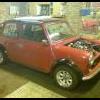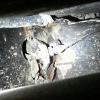Opinions, Doing Away With Engine Mounted Fan?
#16

Posted 16 July 2011 - 06:38 PM
#17

Posted 16 July 2011 - 09:33 PM
#18

Posted 16 July 2011 - 09:35 PM
Some of the 80's cars namely Ford Granadas had only mechanical fans but were fitted with a thermostatic clutch device between the pully and fan shaft that allowed you to stop the fan by hand ( not recommended) when it sensed the engine temp was normal/low on higher engine temps the fan clutch engaged fully allowing the oversized fan at idle to cool the engine very efficiently, at high motorway speeds it was all but disengaged because the air flow was so great it was not needed and so saved fuel and noise etc. To me this seemed the most efficient, simple and reliable way to cool an engine. Why it was fazed out I have no idea.
Because it was crap and didn't work!!
#19

Posted 17 July 2011 - 06:41 AM
Yes. not suggesting getting rid of a radiator fan all together, just replacing it with an electric version.You need the engine fan, without which you would have little/no air flow through the radiator
Sorry man, but that's just complete BS... Heat transfer isnt instant, by the time all the heat you've generated from a high rpm/load stint reaches the radiator, your probably stopped sitting at a set of lights, and the engine is just ticking over. The thermostat determines the amount of heat pumped into the radiator for cooling... This is why vehicle cooling systems are designed with enough capacity to sink a specific amount of heat, and to shift enough air and water at tick over to remove this heat. The flow from the electric fan would be comparable to that of the engine driven fan with the motor on full song, and it's operation controlled by a thermo switch in the bottom rad hose. Water = over 90 degC, fan on, water = under 85 degC, fan off. No need for any fancy schmancy variable speed fan malarky.The first is that the mechanical fan moves air through the radiator at a rate determined by the engine revs. The higher the revs, the more heat needs to be removed and the faster the fan rotates which, of course, shifts a greater volume of cooling air.
Thus a variable-speed fan is needed if the volume of cooling air is to match the generation of heat.
The points raised about the mini radiator location being more suited to a traditional engine mounted fan give lots of pause for thought however... I haden't considered that the electric fan I have would see many more hours in operation than usual due to there being no airflow from the car's motion, that's a bloody good point really and has leaned me right back to the mechanical fan. If the electric fan will be on all the time its just going to cause the alternator to have to work harder all the time, sapping power from the engine anyway. Which system is more efficient however, I have no idea.
My basic thoughts about fitting an electric fan were to avoid having and engine driven fan spinning at 5000rpm, as I imagine that must take a noticable amount of power to do. Below are a couple of pictures of the fan and radiator, just to show what I was on about.
Mounted engine side

or mounted wheel side

#20

Posted 17 July 2011 - 07:56 AM
Zac - I don't think that the life of the fan is something that you need to be concerned about electric motors are very reliable, we have machines at our factory with cooling fans on and they run 24 - 7 for the last 20 years! I would mount the fan the wing side (that's where mine is) and the switch in the bottom of the circuit, hook up a reliable temperature gauge and go out for a drive! I had my car running in the garage while trying to set the fuelling / timing last summer and the ambient temperature was easily 30 degrees and my fan kept the car sitting perfectly at 80 for about 45 minutes. The most demanding situation for heat removal is whilst stationary. Maybe hook up an led to the fan circuit to see if it comes on when cruising?
#21

Posted 17 July 2011 - 08:03 AM
#22

Posted 17 July 2011 - 08:53 AM
#23

Posted 17 July 2011 - 08:54 AM
#24

Posted 17 July 2011 - 10:55 AM
To me this seemed the most efficient, simple and reliable way to cool an engine. Why it was fazed out I have no idea.
Because it was crap and didn't work!!
It wasn't phased out, thermo-viscous fan hubs are very effective and quite common. They certainly aren't restricted to Fords of any particular period, but are generally only used on larger engined vehicles, mainly because they have larger rads and viscous hubs need to be quite large in order to work. They completely cover a small rad as found in the Mini. Also of course, they are only used on in-line engined vehicles. Very few vehicles with transverse engines have had a mechanically driven fan behind a front mounted rad, it demands a stupidly complicated pulley and belt run that leads to early failure.
I would think the amount of air flowing through through the engine bay at normal speeds would be more than sufficient to remove the required amount of heat, bear in mind you want it to run at about 75 - 80 degrees the air moving past it
Air moving past the rad is no use at all though, it has to move through the rad to do anything. As ever, the air will take the path of least resistance through the engine bay, which is in the front and out the back under the floor when travelling forwards. Air as such flows past the rad, there is nothing there to drive it through the cores which is where the cooling happens. This is why there must be a ducted fan in a side mounted rad Mini that must essentially run all the time.
we have machines at our factory with cooling fans on and they run 24 - 7 for the last 20 years!
Which are normally large motors, presumably 1/4hp units, with heavy shafts, substantial bearings and most importantly serviceable brushes and commutators designed specifically for that use. Pancake motors as used in car cooling fans are not designed for a permanant duty cycle. They are even less substantial than those used in computer fans and all of us must know of at least one computer lost to a dead fan.
The real problem of overheating is when the car is stationary or very slow moving, the amount of air moved across the rad by the mechanical fan wont be that much. Increasing the air flow at low speeds is the problem and can be achieved by:-
1) increasing the pulley diameter to get a greater fan speed, but this also increases the water pump speed and i believe this causes cavitation at higher speeds. (not good)
The mechanical fan is far more effective at moving huge volumes of air than an electrical one of the same physical size, the motors in small fans aren't big enough. Stand next to the passenger wing of a running Mini to find out. It's about the best place in the world to be on a cold day. When the car is covered in snow, watch where it clears first when warming up. That's all heat being pulled out of the coolant. To run the pump faster demands a smaller pulley, not larger. As you say though this does increase cavitation which is why the A+ was fitted with the larger, low speed pulley. But running the pump faster does not always increase the heat transfer through the coolant anyway. A variable speed electric pump governed by temperature, that keeps the coolant moving at an appropriate speed at all times is most efficient. You will notice these pumps are not driven by pancake motors.
#25

Posted 17 July 2011 - 02:49 PM
The fans i was referring are electrical cabinet cooling fans and they run constantly, also car fans in hot countries arent different to that of the ones sold here in sunny ol England and i am sure they run alot more than the same car over here. Fans hardly ever fail, go to a breakers yard and see all the broken cars there i bet it aint cause the fan stopped working and i bet if you picked one out and hooked it up to a battery it would work.
The amount of airflow is dictated by the RPM, the blade design and many other complex things not whether it is mechanical or electrical, i am sure fan blade technology has progressed a little since the mini fan was designed. Have you felt an electric fan when it kicks in?
There is no arguing that when the cooling most required (at very low airflow situations) you need the most volume of air being drawn / pushed over the rad as possible and the electric fan moves alot more air than the mechanical fan at tickover speeds.
I conceed the fact that a smaller pulley increases the pump speed, my bad
I am not a thermo or fluids expert but i believe my fundamentals are correct, if there is someone here who has a good understanding of heat transfer and fluid flow and can tell me where i am incorrect i am always willing to learn.
#26

Posted 04 April 2012 - 03:19 PM
Was there any luck with this?
Moss actually sell a revotec kit that says it will do away with the mechanical fan so surely it's ok to do it!?
I'm tempted to go electric with my minus.
#27

Posted 04 April 2012 - 03:34 PM
I dont understand why everybody is flaming the idea. At the end of the day, a fan is a fan. if an electric fan can push the same amount of air as the mechanical fan, what's the problem?
#28

Posted 04 April 2012 - 07:43 PM
My car won't get used very often and after searching around i have found a few kits that are designed to remove the mechanical fan completely.
I'm just going to get one and see what happens. No harm in trying will only see the temperature gauge sneak up then switch of the engine to let it cool with the fan still running......
#29

Posted 04 April 2012 - 08:38 PM
Any one had exprerience with any of the kits?
#30

Posted 04 April 2012 - 09:08 PM
0 user(s) are reading this topic
0 members, 0 guests, 0 anonymous users





















